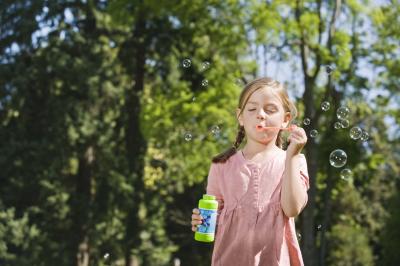Kids face many pressures and sources of stress including school and home situations. Breathing exercises are an option for stress management in children. Deep breathing by itself might be challenging for younger children, but adding a child-friendly aspect makes the exercises easier and more effective. Kids can perform some breathing exercises in the classroom as well as at home.
Bubble Blowing
Bubbles are popular with many kids. They also work well for teaching children to control breathing. Shallow breaths affect bubble production differently than deeper breaths. Fast breaths usually produce lots of smaller bubbles while slower breaths tend to create larger bubbles. Challenge your child to create specific types of bubbles to help him focus on his breaths. Encourage him to take a big, deep breath so he can blow more bubbles in one breath. This activity also works with a pinwheel or a party blower. By controlling breathing, the child make the pinwheels move fast or slow. A deeper breath released at a slower rate allows the child to spin the pinwheel for a long time.
Visualized Breathing
Deep breathing might get boring for some kids. Add a visualization element to deep breathing to make it more appealing. The Family Education website suggests using the visualization of color to help children relax. Blue and green are often considered relaxing colors, so you might ask your child to imagine she is breathing in one of those colors and filling her body with it. The same concept works for light, warmth and other sensations. Another option is to describe a relaxing scene to your child as she focuses on breathing deeply with her eyes closed. Give her enough detail about a scene like the beach or a mountaintop so she can picture it in her mind as she breathes.
Humming
Humming adds an extra element to kids’ breathing exercises. Have your child start with a deep breath in through the nose. As she exhales, encourage her to make a humming or buzzing sound. A deeper breath allows the child to hum for a longer period of time. Challenge kids to see how long they can hum to encourage deeper breaths.
Flower and Candle Technique
Deep breathing usually involves inhaling through the nose and exhaling through the mouth. If a child struggles with this concept, the flower and candle visualization may get him on the right track. Have your child imagine he is smelling a flower, which encourages breathing in through the nose. For exhaling, have him imagine he is blowing out candles; this causes relaxation through the mouth.





